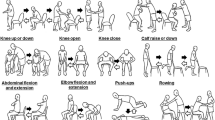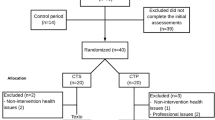Abstract
Age-related decline in maximal concentric muscle power is associated with frailty and functional impairments in the elderly. Compared to concentric contraction, mechanical muscle output is generally enhanced when muscles are rapidly pre-stretched (eccentric contraction), albeit less pronounced with increasing age. Exercise has been recommended to prevent loss of muscle power and function and recent guidelines indicate training program for increasing muscle power highly relevant for elderly subjects. This study examined the differences in muscle power, force and movement pattern during concentric-alone and coupled eccentric–concentric contraction and selected functional motor performances before and after 36-week multicomponent training including aerobic, strength, balance, flexibility and coordination components in elderly males. Vertical force, excursion, velocity, power and acceleration of the body center of mass were measured in two standardised vertical jumps (squatting jump, SQJ; countermovement jump, CMJ). Pre-stretch enhancement during CMJ did not improve performance [i.e., no enhanced maximal muscle power (P peak) and jump height (JH)] compared to concentric-alone muscle contraction (SQJ). Nevertheless, pre-stretch enhancement occurred as for similar SQJ and CMJ maximal performance, elderly people employed lower mechanical work, higher mean muscle power (P mean), shorter concentric phase duration and shorter body center of mass displacement during CMJ. Post training, CMJ Ppeak, P mean and JH increased in training group (P < 0.05) while P peak and JH decreased in control group during the CMJ and SQJ (P < 0.05). In conclusion, long-term training counteracted the age-related decline in muscle power and functional performance observed in the control subjects, while substantial gains in muscular performance were observed in the trained elderly.


Similar content being viewed by others
References
Bassey EJ, Fiatarone MA, O’Neill EF, Kelly M, Evans WJ, Lipsitz LA (1992) Leg extensor power and functional performance in very old men and women. Clin Sci (Lond) 82(3):321–327
Bobbert MF, Gerritsen KGM, Litjens MCA, VanSoest AJ (1996) Why is countermovement jump height greater than squat jump height? Med Sci Sports Exerc 28(11):1402–1412
Bosco C, Komi PV (1980) Influence of aging on the mechanical behavior of leg extensor muscles. Eur J Appl Physiol Occup Physiol 45(2–3):209–219
Bosco C, Viitasalo JT (1982) Potentiation of myoelectrical activity of human muscles in vertical jumps. Electromyogr Clin Neurophysiol 22(7):549–562
Bosco C, Montanari G, Tarkka I, Latteri F, Cozzi M, Iachelli G, Faina M, Colli R, Dal Monte A, La Rosa M (1987) The effect of pre-stretch on mechanical efficiency of human skeletal muscle. Acta Physiol Scand 131(3):323–329
Caserotti P, Aagaard P, Simonsen EB, Puggaard L (2001) Contraction-specific differences in maximal muscle power during stretch-shortening cycle movements in elderly males and females. Eur J Appl Physiol 84(3):206–212
Chalmers GR, Knutzen KM (2000) Soleus Hoffmann-reflex modulation during walking in healthy elderly and young adults. J Gerontol A Biol Sci Med Sci 55(12):B570–B579
De Vito G, Bernardi M, Forte R, Pulejo C, Macaluso A, Figura F (1998) Determinants of maximal instantaneous muscle power in women aged 50–75 years. Eur J Appl Physiol Occup Physiol 78(1):59–64
De Vito G, Bernardi M, Forte R, Pulejo C, Figura F (1999) Effects of a low-intensity conditioning programme on VO2max and maximal instantaneous peak power in elderly women. Eur J Appl Physiol Occup Physiol 80(3):227–232
Evans WJ (2000) Exercise strategies should be designed to increase muscle power. J Gerontol A Biol Sci Med Sci 55(6):M309–M310
Fielding RA, LeBrasseur NK, Cuoco A, Bean J, Mizer K, Fiatarone Singh MA (2002) High-velocity resistance training increases skeletal muscle peak power in older women. J Am Geriatr Soc 50(4):655–662
Finni T, Komi PV, Lepola V (2000) In vivo human triceps surae and quadriceps femoris muscle function in a squat jump and counter movement jump. Eur J Appl Physiol 83(4–5):416–426
Foldvari M, Clark M, Laviolette LC, Bernstein MA, Kaliton D, Castaneda C, Pu CT, Hausdorff JM, Fielding RA, Singh MA (2000) Association of muscle power with functional status in community-dwelling elderly women. J Gerontol A Biol Sci Med Sci 55(4):M192–M199
Fukunaga T, Kawakami Y, Kubo K, Kanehisa H (2002) Muscle and tendon interaction during human movements. Exerc Sport Sci Rev 30(3):106–110
Guralnik JM, Simonsick EM, Ferrucci L, Glynn RJ, Berkman LF, Blazer DG, Scherr PA, Wallace RB (1994) A short physical performance battery assessing lower extremity function: association with self-reported disability and prediction of mortality and nursing home admission. J Gerontol 49(2):M85–M94
Häkkinen K, Alen M, Kraemer WJ, Gorostiaga E, Izquierdo M, Rusko H, Mikkola J, Häkkinen A, Valkeinen H, Kaarakainen E, Romu S, Erola V, Ahtiainen J, Paavolainen L (2003) Neuromuscular adaptations during concurrent strength and endurance training versus strength training. Eur J Appl Physiol 89(1):42–52
Heitmann BL (1990) Evaluation of body fat estimated from body mass index, skinfolds and impedance. A comparative study. Eur J Clin Nutr 44(11):831–837
Holsgaard LA, Caserotti P, Puggaard L, Aagaard P (2007) Reproducibility and relationship of single-joint strength vs multi-joint strength and power in aging individuals. Scand J Med Sci Sports 17(1):43–53
Izquierdo M, Aguado X, Gonzalez R, Lopez JL, Häkkinen K (1999a) Maximal and explosive force production capacity and balance performance in men of different ages. Eur J Appl Physiol Occup Physiol 79(3):260–267
Izquierdo M, Ibanez J, Gorostiaga E, Garrues M, Zuniga A, Anton A, Larrion JL, Häkkinen K (1999b) Maximal strength and power characteristics in isometric and dynamic actions of the upper and lower extremities in middle-aged and older men. Acta Physiol Scand 167(1):57–68
Izquierdo M, Häkkinen K, Ibanez J, Garrues M, Anton A, Zuniga A, Larrion JL, Gorostiaga EM (2001) Effects of strength training on muscle power and serum hormones in middle-aged and older men. J Appl Physiol 90(4):1497–1507
Komi PV (2000) Stretch-shortening cycle: a powerful model to study normal and fatigued muscle. J Biomech 33(10):1197–1206
Lindle RS, Metter EJ, Lynch NA, Fleg JL, Fozard JL, Tobin J, Roy TA, Hurley BF (1997) Age and gender comparisons of muscle strength in 654 women and men aged 20–93 yr. J Appl Physiol 83(5):1581–1587
Magnusson SP, Beyer N, Abrahamsen H, Aagaard P, Neergaard K, Kjaer M (2003) Increased cross-sectional area and reduced tensile stress of the Achilles tendon in elderly compared with young women. J Gerontol A Biol Sci Med Sci 58(2):123–127
Paasuke M, Ereline J, Gapeyeva H (2003) Age-related differences in knee extension rate of isometric force development and vertical jumping performance in women. J Sports Med Phys Fitness 43(4):453–458
Puggaard L (2003) Effects of training on functional performance in 65, 75 and 85 year-old women: experiences deriving from community based studies in Odense, Denmark. Scand J Med Sci Sports 13(1):70–76
Reuben DB, Siu AL (1990) An objective measure of physical function of elderly outpatients. The Physical Performance Test. J Am Geriatr Soc 38(10):1105–1112
Singh MA (2002) Exercise comes of age: rationale and recommendations for a geriatric exercise prescription. J Gerontol A Biol Sci Med Sci 57(5):M262–M282
Skelton DA, Greig CA, Davies JM, Young A (1994) Strength, power and related functional ability of healthy people aged 65–89 years. Age Ageing 23(5):371–377
Skelton DA, Kennedy J, Rutherford OM (2002) Explosive power and asymmetry in leg muscle function in frequent fallers and non-fallers aged over 65. Age Ageing 31(2):119–125
Svantesson U, Grimby G (1995) Stretch-shortening cycle during plantar flexion in young and elderly women and men. Eur J Appl Physiol Occup Physiol 71(5):381–385
Vestergaard S, Kronborg AC, Korsholm L, Puggaard L (2006) Exercise intervention of 65+-year-old men and women: functional ability and health care costs. Aging Clin Exp Res 18(3):227–234
Acknowledgments
The authors are grateful to Henrik Sorensen and Anders Holsgaard Larsen for the fruitful discussion, to Kirsten Kjaer for her valuable laboratory work, and to all participants in the project.
Author information
Authors and Affiliations
Corresponding author
Rights and permissions
About this article
Cite this article
Caserotti, P., Aagaard, P. & Puggaard, L. Changes in power and force generation during coupled eccentric–concentric versus concentric muscle contraction with training and aging. Eur J Appl Physiol 103, 151–161 (2008). https://doi.org/10.1007/s00421-008-0678-x
Accepted:
Published:
Issue Date:
DOI: https://doi.org/10.1007/s00421-008-0678-x




